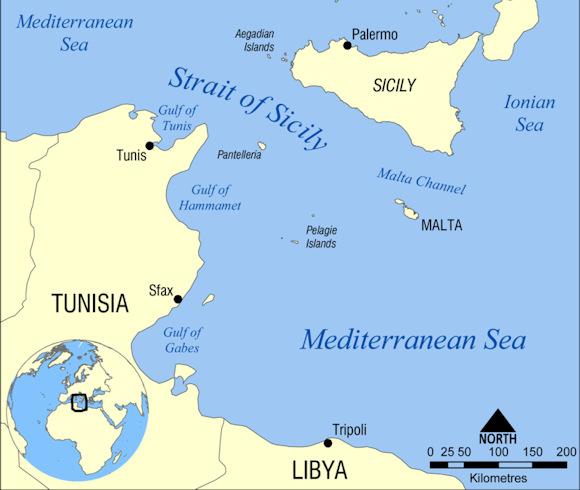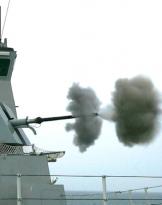With the battle of mid-June (o battle of Pantelleria) refers to a series of air-naval clashes that occurred between 12 and 16 June 1942 in the central and eastern Mediterranean. The fighting, which takes place in the wider battle of the Mediterranean, saw the Italian and German air and naval forces Italy oppose two operations to supply the island of Malta, conducted by the British Royal Navy with British, Australian and Polish units).
These operations, taking place in a very large area of the Mediterranean, were distinguished according to the routes; the convoy escort operation from Alexandria in Egypt was called Vigorous while the one departing from Gibraltar Harpoon, both converging on Malta.
Malta
Since Italy's entry into the war in June 1940, Malta had acquired an important strategic role; the island, located almost in the center of the Mediterranean, during the conflict was of considerable importance in the context of the North African campaign, being both on the route used by the Italians to supply the troops stationed in Libya and on the shorter one between the United Kingdom and forces in Egypt.
In fact, at the outbreak of war, the island was largely undefended: its position made it so vulnerable to Italian attacks that the British had assumed its imminent invasion for certain, consequently taking steps to remove their air forces from the island and naval forces and to evacuate key personnel. However, in the days and months that followed, it became increasingly clear that there was no real attempt at invasion, even because the high command of the Italian forces had not prepared any plans for this eventuality (it will do so only in October 1941 with the so-called operation C3).
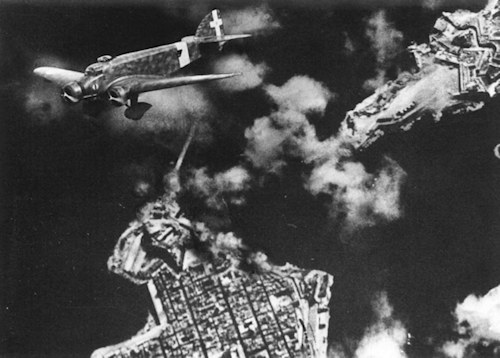 The British therefore proceeded to reinforce the island's defenses and transform it into a base for their air, naval and underwater units to be engaged in attacks against Italian traffic bound for Libya.
The British therefore proceeded to reinforce the island's defenses and transform it into a base for their air, naval and underwater units to be engaged in attacks against Italian traffic bound for Libya.
For the following two years several clashes took place in the waters off Malta: if the British vessels based on the island managed to obstruct the enemy's supply routes, the Italian ones conversely dedicated themselves to attacking the cargo carrying everything necessary to support the defense of the Maltese archipelago.
The problem of supplying Malta gradually became more and more onerous for the Royal Navy since, in addition to the supply of all that was needed to make the island a military base (aircraft, ammunition, spare parts and military supplies), it was necessary to maintain a flow as constant as possible of basic necessities such as food and fuel, necessary not only for military personnel but also for the large civilian population.
The British navy brought resources and supplies to the island via aircraft, transported from aircraft carriers, launched towards the island's airfields once they were as far away as possible, while small quantities of vital materials such as ammunition, medicines and food were delivered by merchant ships fast or by military units or submarines used as means of transport; among them should be mentioned the minelayer HMS Welsman (following photo), a fast unit of the class Abdiel from 40 knots, which distinguished itself in this type of activity, making numerous supply voyages to and from Malta and for this also obtaining a commendation from the British Prime Minister Winston Churchill.
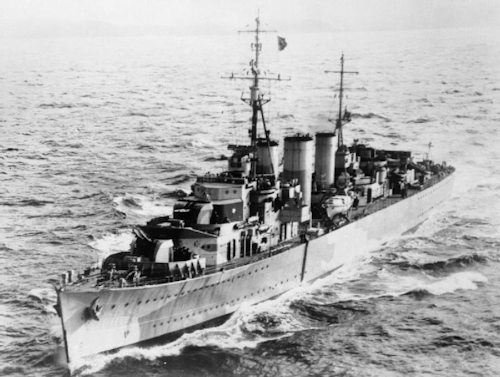 However, the method that guaranteed a greater flow of resources remained that of organizing a vast naval convoy, made up of the greatest possible number of merchant ships; since due to their size the convoys could not fail to attract the attention of the enemy, it was however necessary to guarantee them a massive military escort, using the resources of the two British naval formations employed in the waters of the Mediterranean: the "Mediterranean Fleet" ) based in Alexandria in Egypt and "Force H" based in Gibraltar.
However, the method that guaranteed a greater flow of resources remained that of organizing a vast naval convoy, made up of the greatest possible number of merchant ships; since due to their size the convoys could not fail to attract the attention of the enemy, it was however necessary to guarantee them a massive military escort, using the resources of the two British naval formations employed in the waters of the Mediterranean: the "Mediterranean Fleet" ) based in Alexandria in Egypt and "Force H" based in Gibraltar.
At the behest of Adolf Hitler himself, the Kriegsmarine deployed a contingent of U-boats in the Mediterranean from September 1941, immediately obtaining several successes: on November 14, 1941, the submarine U-81 torpedoed and sank the aircraft carrier HMS Ark Royal while returning from an aircraft transport mission to Malta, while the following 25 November U-331 sank the battleship HMS Barham while participating with the rest of the fleet searching for enemy convoys in the eastern Mediterranean.
The war capabilities of the Mediterranean Fleet suffered a severe blow on 19 December 1941, when raiders of the Italian Xª Flottiglia MAS penetrated the port of Alessandria and attacked the two battleships HMS Queen Elizabeth and HMS Valiant: the two units were sunk even if they landed on the shallow seabed of the port, subsequently allowing their recovery; in fact, a horribilis period for the British fleet which found itself without operational battleships in the Mediterranean sector.
On 16 January 1942 dozens of Italian and German generals and admirals met in Garmisch-Partenkirchen to resume the Italian invasion plan of the island, also advised by Japanese consultants: it was decided to disembark the troops only after a bombardment of increasing intensity, which was supposed to completely undermine the resistance of the British garrison.
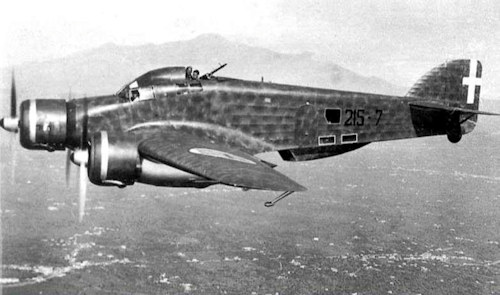
It seemed that the balance of the naval confrontation in the Mediterranean was shifting in favor of the Axis forces; Reinforced by aircraft from the Luftwaffe's X Fliegerkorps, the German Air Force and Regia Aeronautica had begun subjecting Malta to a series of extensive aerial bombardments, inflicting enormous damage and compromising the garrison's strength.
Meanwhile the landing craft were being prepared and the paratroopers were being trained; the continuous air raids, which in the month of March 1942 alone discharged ten times the quantity of bombs dropped by the Germans during the bombing of Coventry, forced the British to withdraw their naval forces stationed on the island.
The renewed air and naval offensives of the Axis forces therefore made the supply operations of the island complicated: between 22 and 26 March 1942, during the events of the so-called second battle of the Sirte, a British convoy, although abundantly escorted, had seen the sinking from the air attacks of the Axis all four merchantmen that composed it, two of which inside the port of Valletta itself shortly after having landed there, for which only 5.000 of the 26.000 tons of supplies transported had been able to be delivered.
About 10% of what was sent continued to arrive on the island, and this had repercussions on the resistance of the garrison: food and ammunition were scarce, and morale was very low.
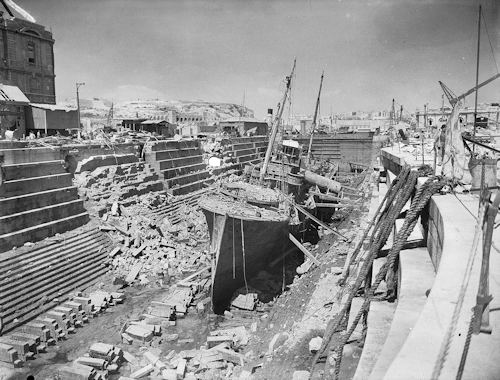
In mid-May 1942, after a worrying report from the new governor of Malta, Lord Gort, communicated that the island had food for only three months, the commander of the Mediterranean Fleet, Vice Admiral Henry Harwood, decided to organize a new massive resupply mission.
To ensure that at least part of the cargo could reach its destination, this time there would be two convoys: the first (“Harpoon“) would leave from Gibraltar while the other (“Vigorous“), from Alexandria. According to the Admiralty, faced with two convoys simultaneously, the Axis forces would split, thus allowing each convoy to face acceptable opposition and contain casualties, or concentrate on only one, allowing the 'else to arrive at the goal undisturbed.
The convoy Harpoon would be assembled in Gibraltar with merchantmen from the United Kingdom: the supplies would be transported by three British freighters (Troilus, Orari and Burdwan), one Dutch (Tanimbar) and one US (Chant), while a vital cargo of fuel would be brought from the US tanker Kentucky; supplies would also be loaded onto the minelayer HMS Welshman, which would join the convoy at Gibraltar to accompany it part of the way to Malta, then break away to take advantage of its superior speed and rejoin the convoy on 15 June after unloading its material.
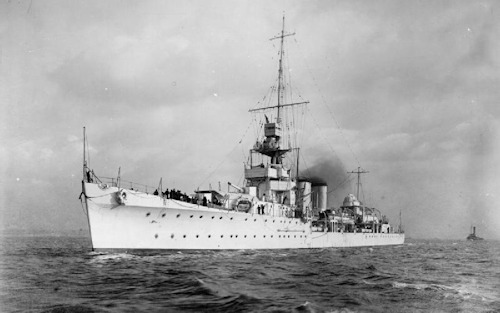 The convoy escort, led by Vessel Captain Cecil Campbell Hardy, would be formed by the light cruiser HMS Cairo (photo), by nine destroyers (of which one, the ORP kujawiak, British-built but sold to the Polish Navy), four minesweepers and six motor gunboats of the type Fairmile B (also equipped as minesweepers); having passed Gibraltar, the convoy would have been escorted at a distance up to the mouth of the Sicilian channel by the "Force W" of Vice Admiral Alban Curteis, with the aircraft carriers HMS Argus and HMS Eagle (which they embarked Fulmar, Swordfish e Sea Hurricane of Naval Air Squadrons 801, 807, 813, 824), the battleship HMS Malaya, the light cruisers HMS Kenya (flagship), HMS Charybdis and HMS Liverpool and eight destroyers. The tanker Brown Ranger, escorted by two corvettes (Force Y), would have refueled the destroyers escorting the convoy at sea.
The convoy escort, led by Vessel Captain Cecil Campbell Hardy, would be formed by the light cruiser HMS Cairo (photo), by nine destroyers (of which one, the ORP kujawiak, British-built but sold to the Polish Navy), four minesweepers and six motor gunboats of the type Fairmile B (also equipped as minesweepers); having passed Gibraltar, the convoy would have been escorted at a distance up to the mouth of the Sicilian channel by the "Force W" of Vice Admiral Alban Curteis, with the aircraft carriers HMS Argus and HMS Eagle (which they embarked Fulmar, Swordfish e Sea Hurricane of Naval Air Squadrons 801, 807, 813, 824), the battleship HMS Malaya, the light cruisers HMS Kenya (flagship), HMS Charybdis and HMS Liverpool and eight destroyers. The tanker Brown Ranger, escorted by two corvettes (Force Y), would have refueled the destroyers escorting the convoy at sea.
The eleven merchant ships, including cargo and tankers, assigned instead to the operation Vigorous they would set sail from various ports, divided into several sections, to then reunite at sea in a single convoy (identified as MW.11): section 11A, with the steamers Ajax, City of Edinburgh, City of Lincoln, City of Pretoria ed Elizabeth Bakke section 11B with the tanker would have departed from the port of Haifa bulkoil and cargo potaro would have moved from Alexandria while the 11C would have put to sea from Port Said with the steamers Aagtekerk, Bhutan, City of Calcutta e Rembrandt.
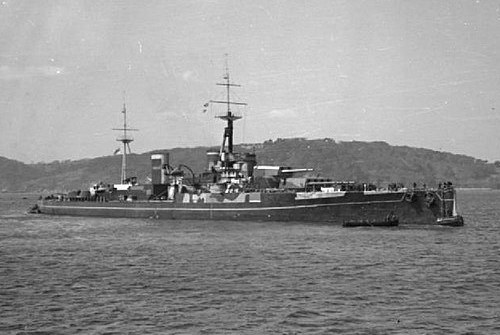
The escort, under the command of Rear Admiral Philip Vian, embarked on the cruiser HMS Cleopatra, included a considerable number of the surviving units of the Mediterranean Fleet, numbering eight light cruisers, 26 destroyers (including four Australian), two minesweepers and four corvettes; HMS was also attached to the convoy Centurion (photo), an old battleship of the class King George V launched in 1911 which had been converted into a gunnery practice target ship due to her obsolescence, to resemble the battleship HMS Anson and thus deceiving enemy reconnaissance she was disguised with false wooden superstructures and was loaded with an additional 2.000t of supplies; in fact the ship had only thirteen 20mm machine guns to defend her.
As further support to the two convoys, a dozen British submarines were stationed in the Ionian Sea and in the central Mediterranean with the task of intercepting any Axis naval formations heading towards them; large formations of fighter planes stationed in Malta, Egypt and Palestine were also assigned to protect cargo and attack enemy units, including a contingent of US Consolidated B-24 bombers Liberator at their first use in the Mediterranean theater.
Various preventive actions were also attempted to hinder possible interventions by the Axis forces: the port of Taranto, the main base of the Regia Marina, was attacked by British bombers on the nights of 9, 10 and 11 June, even if with little effect, while the two Greek submarines Triton and Papanikolis landed SOE saboteurs (precisely three groups of the Special Boat Service, then “Special Boat Section“, and one of the Special Air Service) in Crete in the night between 13 and 14 June with the task of attacking the airports of Candia, Kastelli Pediados, Timbaki and Maléme, managing to destroy some aircraft in Candia and 5 others, 29 were damaged with 200 tons of aviation gasoline at Kastelli during the operation albumen.
Italian forces
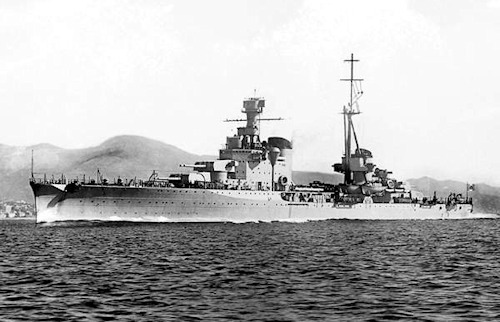
In June 1942, the Italian squadron was in difficulty due to the unavailability of many of its major units, some still out of action after the night in Taranto: of the seven battleships available, the Count of Cavour was in Trieste for repair work, the Duilio was in Messina in training, the Julius Caesar had flown her last operational mission with convoy escort M43 during January 1942, theAndrea Doria from March 1942 he was stationary in Taranto to contribute to the anti-aircraft defense of the base, while the brand new battleship Roma it was still in preparation; of heavy cruisers, the whole class Zara, with the exception of the Gorizia, had been lost during the battle of Cape Matapan, while the Bolzano (photo) he had remained in Palermo to the disappointment of the divisional admiral Alberto Da Zara and the Trieste was still under repair for damage caused by a torpedo received on 21 November 1941 from the submarine HMS utmost.
Of the twelve light cruisers in the class Condottieri with which the Regia Marina had started the conflict, five had been sunk, one, the Luigi Cadorna, had been declared unsuitable for team duties due to poor protection, the Duca degli Abruzzi was in Navarino for the protection of convoys such as the Muzio attendolo between Naples and Benghazi or towards Albania; plus the newest light cruisers in the class Roman Captains were still under construction, with only theAttilio Regolo recently entered service was still engaged in exercises.
The main battle force, under the command of squadron admiral Angelo Iachino, was located in Taranto being able to count on two battleships, two heavy cruisers, two light cruisers and twelve destroyers; Alberto Da Zara's VII cruiser division was instead located in Cagliari, with two light cruisers and seven destroyers, available for operations in the western Mediterranean.
Light units such as MAS and torpedo boats and submarines could be deployed as mobile barriers along the Sicilian Channel, while air support could be provided by the formations of the Regia Aeronautica and X Fliegerkorps located in Sicily, Sardinia and Crete, in an operation that it would have proved to be very coordinated unlike similar experiences of lack of cooperation between the navy and the air force such as during the battle of Punta Stilo.
In the next two articles we will deal with the two operations, Harpoon e Vigorous and the consequences of the clash against the Italian-German forces.
Read second part - The naval battle of Pantelleria, also known as the "battle of mid-June": Operation Harpoon
Read part three - The naval battle of Pantelleria, also known as the "battle of mid-June": Operation Vigorous
Photo: Norman Einstein - wikimedia commons / web / IWM
(article originally published on https://www.ocean4future.org)

